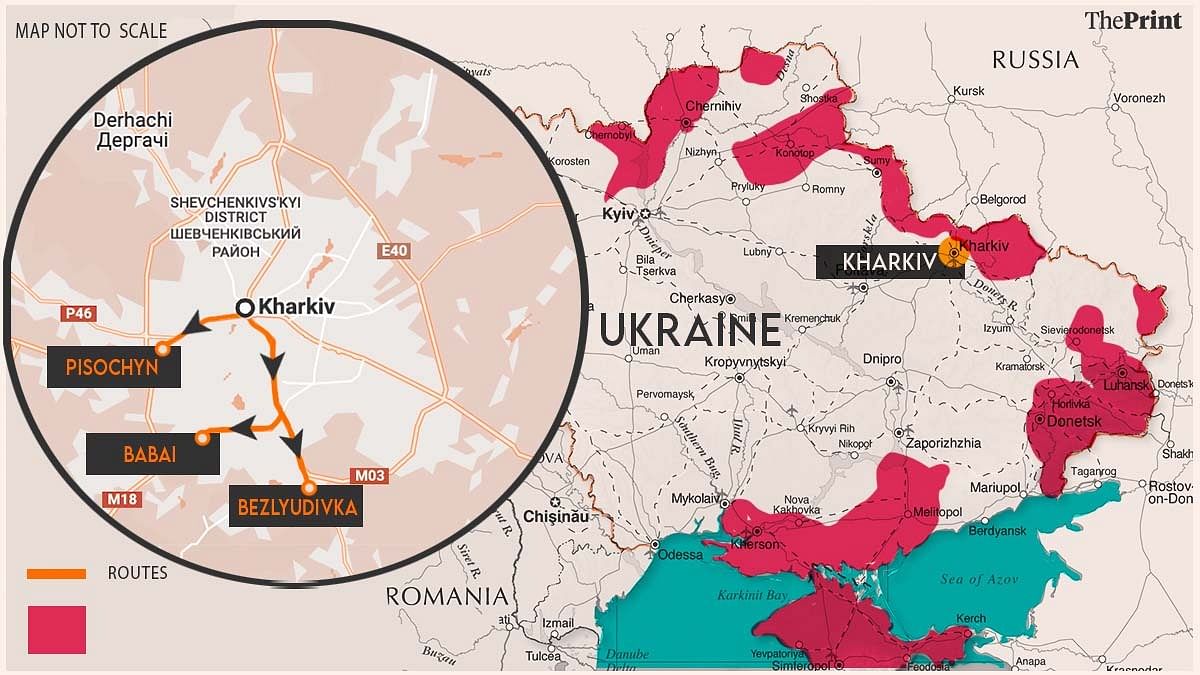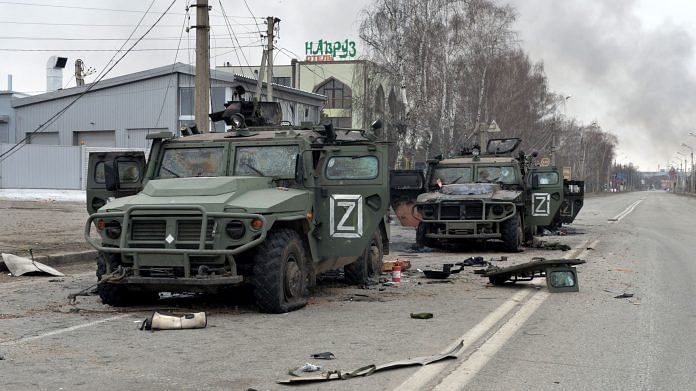New Delhi: Around 4,000 Indian students remain stuck in underground bomb shelters in Ukraine’s Kharkiv as fighting between Russian and Ukrainian forces intensified and inched closer to their locations.
The Indian embassy in Ukraine Wednesday issued two “urgent advisories” directing Indian nationals in Kharkiv to leave the city immediately and reach three settlements — Pisochyn, Bezlyudivka and Babai — by 9.30 pm IST (6 pm Ukrainian time).
2nd Advisory to Indian Students in Kharkiv
2 March 2022.@MEAIndia @PIB_India @DDNewslive @DDNational pic.twitter.com/yOgQ8m25xh
— India in Ukraine (@IndiainUkraine) March 2, 2022
Kharkiv is located in eastern Ukraine just north of the Donbas region. While most of the Indian students stuck in the city are enrolled at Kharkiv National Medical University (around 3,500), the others are from colleges like V. N. Karazin Kharkiv National University and Kharkiv International Medical University.
By foot, Pisochyn is 11 km west of Kharkiv’s city centre, Bezlyudivka is 16 km south and Babai is 12 km southwest.

Earlier in the day, Russia said it is working on launching a “humanitarian corridor” for evacuation of Indian nationals stuck in eastern Ukraine.
Of around 20,000 Indian nationals stuck in Ukraine, over 6,000 have been safely repatriated, Union Minister of State for External Affairs V Muraleedharan said Wednesday, adding that the government is trying to evacuate Indians via Romania, Poland, Hungary, Slovakia and Moldova.
Some students take trains to Lviv, van to Poland border
Though the Indian government has urged Indians in Kharkiv to leave the city, many of them said they are unsure if they can safely make it to Pisochyn, Bezlyudivka or Babai due to the breakdown of public transport, specifically buses, and the threat of air raids.
On Tuesday, an Indian medical student died from shelling when a missile struck an administrative building in Kharkiv. The incident rattled many students hiding out in bunkers, and made them hesitant about leaving.
Some Twitter users also remarked that the advisory from the Indian embassy to leave Kharkiv was released at very short notice, giving Indians just four hours to leave the city.
It's 1340 hrs in Ukraine, right now.
Advisory issued 15 mins back.
Pesochin is 20 mins.
Bezlyudovka is 92 Kms away.
If Babaye is the same as Babayevo, then it's 18 hrs away.
Mind you, the last 2 are across the border in Russia.
And the students have to teach by 18:00 hrs. https://t.co/51btA87Xf6
— Rahul Mukherji (@RahulMukherji5) March 2, 2022
Asked how he and his college mates plan to leave the city, 17-year-old Aditya Singh, a student of Kharkiv National Medical University, told ThePrint over the phone: “We are not taking any route. We are just sitting in metro stations to ensure our safety. Trust me, we are unable to leave.”
Some students have started taking trains from Kharkiv to Lviv and then crossing over to Poland. Lviv is a city just 80 kilometres from the Polish border.
Rohan Dhananjaya, 23, a fifth year student of Kharkiv National Medical University, told ThePrint over WhatsApp call that he and 20-25 of his friends reached the Poland border around 6 pm IST Wednesday.
“We left yesterday around 10 am to catch a train to Lviv. We reached Lviv around 8 am and from there hired a van to Poland. We’re all at the immigration border office right now and have handed over some documents like passports and local residence. The process is quite fast, apparently it takes just 30 minutes,” he added.
Rohan said the trains were very crowded. “I think because there were rumours that this is the last day any trains would be available. Buses are not available, and even then they are not a safe option,” he added.
India’s evacuation efforts compared to US, China, UK
As of early 2020, there were approximately 80,000 international students in Ukraine, according to Ukrainian government estimates. India topped the list with roughly 18,000 students, followed by countries like Morocco, Azerbaijan and Turkmenistan.
After Russian President Vladimir Putin announced military operations in Ukraine on 24 February, the Indian government launched ‘Operation Ganga’ to bring back stranded Indian nationals from the war-hit country via special flights, free of cost.
In contrast, China has pulled back on evacuation efforts. On Sunday, Chinese ambassador Fan Xianrong said current conditions were too unsafe to evacuate citizens — a few days after the embassy said it was making arrangements to help Chinese nationals leave after the Russian invasion.
The United States too closed its embassy in Kyiv on 14 February and moved diplomats to Lviv before relocating to Poland. Five days ago, a US advisory said the government will not be able to evacuate its citizens from Ukraine, and advised them not to use commercially or privately-owned transportation to cross the border.
Last week, the United Kingdom government also informed its nationals that Russia’s military action in Ukraine will “severely affect” its ability to provide consular assistance in the war-hit country, and embassy staff are also operating out of Lviv.
“British Nationals should not expect increased consular support or help with evacuating in these circumstances. A full range of assistance is available in neighbouring countries,” said a 24 February advisory.
On 1 March, the Indian embassy in the Ukrainian capital of Kyiv was shut down, as the Russia-Ukraine war entered its sixth day and diplomats were shifted to Lviv in the western part of the country.
(Edited by Gitanjali Das)
Also Read: ‘Pitiful’ Ukrainians and a dreadful journey: What evacuated Indian students saw & felt






